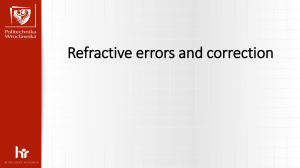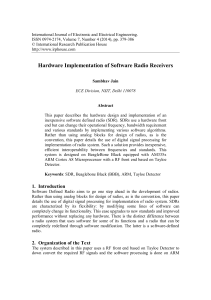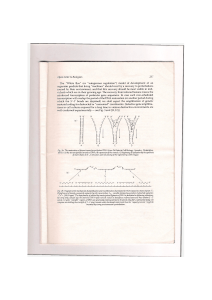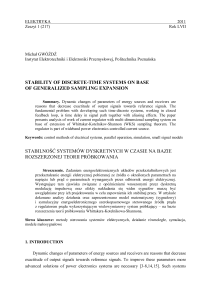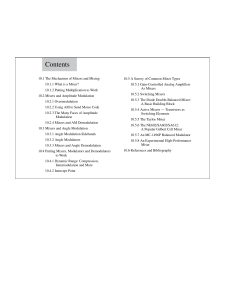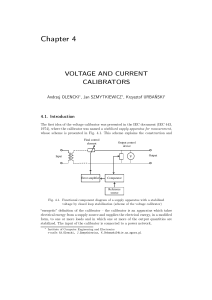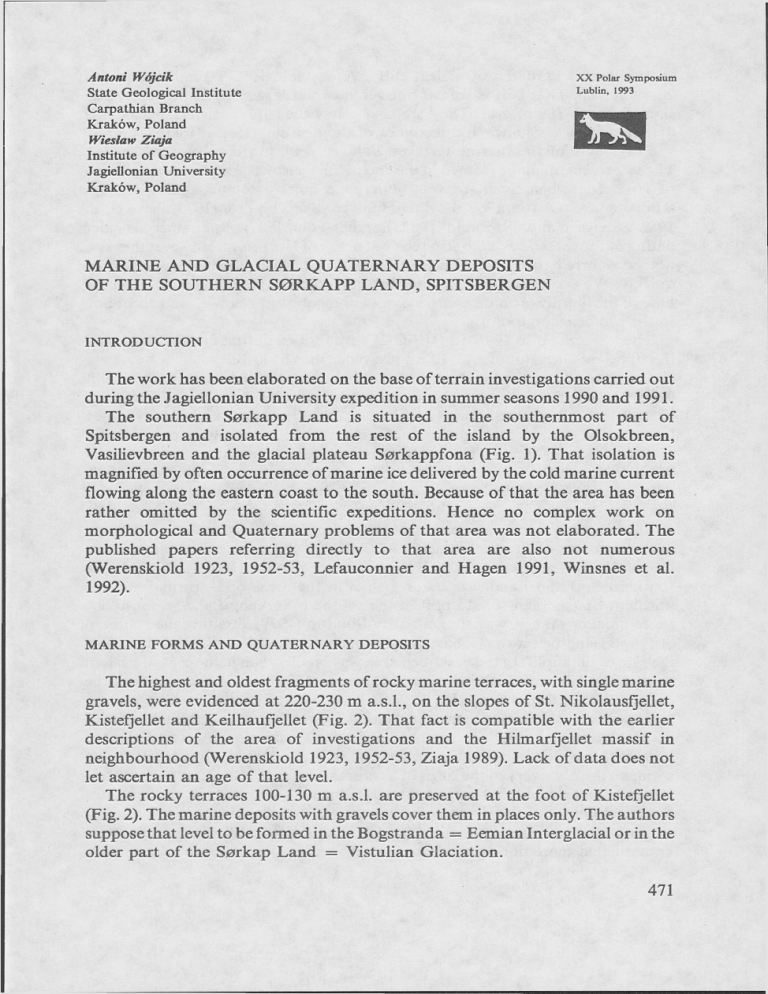
Antoni Wójcik
State Geological Institute
Carpathian Branch
Kraków, Poland
X X Polar Symposium
Lublin, 1993
Wiesław Ziaja
Institute of Geography
Jagiellonian University
Kraków, Poland
MARINE AND GLACIAL QUATERNARY DEPOSITS
OF THE SOUTHERN S0RKAPP LAND, SPITSBERGEN
INTRODUCTION
The work has been elaborated on the base of terrain investigations carried out
during the Jagiellonian University expedition in summer seasons 1990 and 1991.
The southern Sorkapp Land is situated in the southernmost part of
Spitsbergen and isolated from the rest of the island by the Olsokbreen,
Vasilievbreen and the glacial plateau Sorkappfona (Fig. 1). That isolation is
magnified by often occurrence of marine ice delivered by the cold marine current
flowing along the eastern coast to the south. Because of that the area has been
rather omitted by the scientific expeditions. Hence no complex work on
morphological and Quaternary problems of that area was not elaborated. The
published papers referring directly to that area are also not numerous
(Werenskiold 1923, 1952-53, Lefauconnier and Hagen 1991, Winsnes et al.
1992).
MARINE FORMS AND QUATERNARY DEPOSITS
The highest and oldest fragments of rocky marine terraces, with single marine
gravels, were evidenced at 220-230 m a.s.l., on the slopes of St. Nikolausfjellet,
Kistefjellet and Keilhaufjellet (Fig. 2). That fact is compatible with the earlier
descriptions of the area of investigations and the Hilmarfjellet massif in
neighbourhood (Werenskiold 1923, 1952-53, Ziaja 1989). Lack of data does not
let ascertain an age of that level.
The rocky terraces 100-130 m a.s.l. are preserved at the foot of Kistefjellet
(Fig. 2). The marine deposits with gravels cover them in places only. The authors
suppose that level to be formed in the Bogstranda = Eemian Interglacial or in the
older part of the Sorkap Land = Vistulian Glaciation.
471
The level is bordered by a clear cliff (Werenskiold 1952-53) falling down to
20-40 m a.s.l. That cliff is transformed in complexes of skerries in places. The
skerries reach 100 m a.s.l. They are also below the cliff. Their arrangement is
determined by resistance and tectonics of the bedrock (Hecla Hoek).
Fragments of the marine terraces 20-40 m a.s.l. are between the skerries.
Those terraces might be formed in the end of the Pleistocene and in the beginning
of Holocene when Svalbard was undergone quick isostatic uplift (Feyling-Hanssen and Olsson 1960, Feyling-Hanssen 1965, Boulton 1979, Pewe et al.
1982, Salvigsen and Osterholm 1982, Landvik et al. 1987). Not numerous older
dating of those terraces were also received north of Hornsund. However they can
not be referred to the southern Sorkapp Land which has been raised more
quickly. We accept the thesis about that quick uplift „per anlogiam" — on the
base of the literature on the eastern Svalbard mentioned below — and according
to the radiocarbon datings.
The terraces up to 19 m a.s.l. (Fig. 2) were formed during the Holocene, and
the upper of them (above 11-12 m) are older that 6500 B.P.
Laminaria from the raised storm ridge below Mathiasbreen, from the height
9.5 m and the depth 0.7 m, were dated by the radiocarbon method. The result
6580 ±160 B.P. (Gd 6583) was obtained. Almost the same result was obtained
from the 1 4 C dating of the whale bone brought by Eyles and Boulton in the coast
of Bettybukta in the similar height (Forman 1990). Some datings from that
height in the western coast of the central Spitsbergen are similar (Pewe et al. 1982,
Salvigsen 1984a, 1984b, Landvik et al. 1987, Stankowski et al. 1989). However
the other datings from that height in the western and northern Spitsbergen are
1000-1500 years older (Salvigsen and Osterholm 1982, Salvigsen at al. 1990), and
in the northern coast of Hornsund — 2000-3000 years older (Birkenmajer and
Olsson 1970). The results of the datings evidence that the Holocene uplift in the
southern S0rkapp Land was quicker than in the areas of Hornsund and the
northern Spitsbergen. That uplift in the southern Sorkapp Land was also few
times quicker than it was suggested by Boulton (1979) situating the southern
S0rkapp Land below the isobase 2 m for the age 6500 B.P. From the other side,
the rate of that uplift in the described area was smaller than in the central-eastern
coast of Spitsbergen (Salvigsen and Mangerud 1991) and in the islands of the
eastern Svalbard (Salvigsen 1978, 1981, Nagy 1984).
The area of the lowest marine terrace, 2-3 m a.s.l., is enlarged by the marine
accumulation in bays, whereas headlands and peninsulas are wasted by the
abrasion. It is possible to estimate the rate of that accumulation in Bettybukta
owing to the discovery of the ruins of huts in the distance 100-130 m from the sea.
It may be ascertained that they are not older than the 17th century, on the base of
historical data and the degree of preservation of them. Hence two big storm
ridges, with the depressions from the land side, in sum 100-120 m wide, were
accumulated there during the last 300-400 years.
472
GLACIAL FORMS AND QUATERNARY DEPOSITS
The retreat of glaciers has been connected with decreasing a thickness of
glacial ice within both tongues and firn fields. The result of that is a reduction of
the area of glaciers, dividing them and uncovering rocky surfaces with roche
moutonnees. Maximum extent of glaciers in the Little Ice Age is signed by front
moraines and bigger concentrations of erratics (Fig. 1). Fronts of glaciers have
been retreated significantly forming differentiated marginal zones on forefields
since 1936.
The smallest values of deglaciation were obtained for the big Bjelopolskibreen
which was almost stable till 1961. Only after that time the clear retreat of the front
(0.3 km) has been followed. The thickness of the melted ice was estimated at 50
m there. Much bigger values have been received for other glaciers (Fig. 1). The
cirque glacier Lyngebreen has been retreated ca. 0.9 km since 1936. The
reduction of the thickness of that glacier reached 50-60 m, or 1 m of ice per year.
The similar rates were obtained for the southernmost glacier in Spitsbergen
— Mathiasbreen. That glacier was moved back ca. 2 km from the maximum
extent signed by the front moraine, 1 -1.1 km of those 2 km — in the period from
1936 to 1961, and the next 0.45-0.5 km — during the last 30 years (Fig. 1). The
glaciers Dumskoltbreen and Svartkuvbreen (in the east) were retreated ca. 1 km.
The area of Keilhaubreen glacier, which had a wide tide-water front in 1936,
was diminished most of all. Now the front there is ca. 2 km from the sea coast.
The glacier tongue, thick 20-50 m, was moved back 0.6-0.9 km from 1961 to 1991.
The small Toppbreen, on the northern slopes of Keilhaufjellet, was connected
with the Keilaubreen in 1961. Now those glaciers are divided by the area with the
numerous roche moutonnees, 0.1-0.3 km wide. Single gravels and boulders or
a thin ablation moraine occur there in places. Toppbreen is a dead glacier
probably. The similar dividing of glaciers occur west of Dumskolten (Fig. 1).
Rocky outcrops are also appearing in the central part of Bjelopolskibreen.
A subglacial relief influence that dividing most.
The glacial rivers has cut into the mudstones to ca. 5 m in the marginal zone of
Randbreen.
The biggest quantity of glacial deposits in the described area originate from
the Little Ice Age. The ice-cored frontal and lateral moraines are the most clear
and common. Almost all glaciers have those moraines apart from Randbreen
and Keilhaubreen because they reached the sea in 1936. Those glaciers were surge
glaciers (Lefauconnier and Hagen 1991).
Thin patches of the ground and ablation moraine occur directly on outcrops
of the older rocks between complexes of the end ice-cored morainic ridges and the
fronts of the glaciers. It is difficult to distinguish the ground moraine from the
ablation one, especially in the forefields of the Olsokbreen, Lyngebreen and
Mathiasbreen (Fig. 2).
473
Big areas of the fluted (ablation) moraine (Lindner and Marks 1991a) occur in
the forefields of the Keilhaubreen and Randbreen.
The oldest glacial deposits of the southern Sorkapp Land were protected in
the form of erratics. The biggest concentrations of them were evidenced on the
top flattenings and the slopes of Dumskolten and Svartkuven up to 300-360
m a.s.l. Hence it may be considered that glaciers were much thicker in the past.
Those erratics originate from the Pleistocene, from the Sorkapp Land = Vistulian Glaciation probably, for which there are few glacial episodes elaborated
(Lindner and Marks 1991b). However they can be even older.
The marine terraces up to 30 m a.s.l. without any deposits occur outside the
morainic ridges. No glacial deposits were found on the terrace 100-130 m a.s.l.
Hence there are not the traces of the Lower and Middle Holocene glacial
transgressions which would go beyond the extent from the Little Ice Age in the
southern Sorkapp Land.
RECAPITULATION
The deposits of the marine terraces in different hights, with the numerous
skerries in places, cover significant fragments of the not glaciated area. That
system of the terraces is characteristic for the areas raised isostaticly. The bigger
terraces may be connected with the periods of retreating or increasing of the
glaciers. The extensive levels of the terraces from 12-13 to 19 m a.s.l. can be
connected with the glacial advance in the Granfjorden Stage in the Lower
Holocene. The retreat of the glaciers determined the isostatic uplift of the area
and forming the terraces up to 10 m a.s.l. The beginning of that uplift is evidenced
by the raised storm ridge 9-10 m a.s.l. dated 6580 ±160 B.P. ( 1 4 C). The traces of
the younger transgressions are not evidenced, the lower levels are well protected,
without any traces of the marine erosion. Hence the sequence of the transgressions described by Chmal (1987, 1988) in the area of Hornsund does not stand
good in the described area.
The work was done within the project financed by the Ministry of National
Education.
REFERENCES
Birkenmajer K. and Olson I. U., 1970: Radiocarbon dating of raised marine terraces at Hornsund,
Spitsbergen, and the problem of land uplift. Norks Polarinstitutt Arbok 1969, 17-43.
Boulton G. S., 1979: Glacial history of the Spitsbergen archipelago and the problem of a Barents
Shelf ice sheet. Boreas, v. 8, 31-57.
Chmal H., 1987: Pleistocene sea level changes and glacial history of the Hornsund area, Svalbard.
Polar Research 5 n. s., 269-270.
474
Chmal H., 1988: Późnoczwartorzędowe zmiany poziomu morza i historia glacjalna rejonu
Hornsundu. XV Sympozjum Polarne, Uniwersytet Wrocławski, 109-114.
Forman S. L., 1990: Bettybukta series. Svalbard radiocarbon date list I. University of Colorado,
Institute of Arctic and Alpine Research, Occasional Paper 47, 36.
Feyling-Hanssen R. W., 1965: Shoreline displacement in Central Spitsbergen. Norsk Polarinstitutt Meddelelser Nr 93, 1-5.
Feyling-Hanssen R. W. and Olsson I. if., 1959-1960: Five radiocarbon datings of Post Glacial
shorelines in Central Spitsbergen. Norsk Geogr. Tidsskrift, Bind XVII, 122-131.
Landvik J. Y., Mangerud J., Salvigsen O., 1987: The Late Weichselian and Holocene shoreline
displacement on the west-central coast of Svalbard. Polar Research 5 п., 29-44.
Lefauconnier B. and Hagen J. O., 1991: Surging and calving glaciers in eastern Svalbard.
Meddelelser Nr 116, 1-130.
Lindner L. and Marks L., 1991a: Osady czwartorzędowe południowego Spitsbergenu. Przeg.
Geol., nr. 2, 61-67.
Lindner L. and Marks L., 199lb: Outline of Stratigraphy of the Pleistocene and the Holocene in
South and Central Spitsbergen. Bull. Pol. Ac. Earth Sci., 39: 165-172.
Nagy J., 1984: Quaternary glaciomarine deposits and foraminifera from Edgeeya, Svalbard.
Boreas, v., 13, 319-322.
Pewe T. L., Rowan D. E., Pewe R. H., Stuckenrath R., 1982: Glacial and periglacial geology of
northwest Blomeslettapeninsula, Spitsbergen, Svalbard. Norsk Polarinstitutt, SkrifterNr 177,1-32.
Salvigsen O., 1978: Holocene emergence and finds of pumice, whalebones, and driftwood at
Svartknausflya, Nordaustlandet. Norsk Polarinstitutt, Arbok 1977.
Salvigsen O., 1981: Radiocarbon dated raised beaches in Kong Karls Land, Svalbard, and their
consequences for the glacial history of the Barents Sea area. Geogr. Ann. 63A (3-4), 283-291.
Salvigsen O., 1984a: Two observations of pumice levels from west coast Spitsbergen. Polar
Research 2n. s., 115-116.
Salvigsen O., 1984b: Occurrence of pumice on raised beaches and Holocene shoreline
displacement in the inner Isfjorden area, Svalbard. Norsk Polarinstitutt, Polar Research 2 n. s.,
107-113.
Salvigsen O., Elgersma A., Hjort C., Lagerlund E., Liestol O., Svensson N. O., 1990: Glacial
history and shoreline displacement on Erdmannflya and Bohemanflya, Spitsbergen, Svalbard. Polar
Research 8, 261-273.
Salvigsen O. and Mangerud J., 1991: Holocene shoreline displacement at Agardhbukta, eastern
Spitsbergen, Svalbard. Polar Research 9(1), 1-7.
Salvigsen O. and Ósterholm H., 1982: Radiocarbon dated raised beaches and glacial history of the
northern coast of Spitsbergen, Svalbard. Polar Research 1, 97-115.
Stankowski W., Kasprzyk L., Kostrzewski A., Ryglewski W., 1989: An outline of morphogenesis
of the region between Horbyedalen and Ebbadalen. Petuniabukta, Billefjorden, central Spitsbergen.
Polish Polar Research, v. 10, 4, 267-276.
Werenskiold W., 1923: Hoie strandlinjer pi Spitsbergen. Norsk. Geol. Tidsskrift, v. VII (1), 7-12.
Werenskiold W., 1925-53: The Strand Flat of Spitsbergen. Norsk Geogr. Tidsskrift, Bind 52,
301-309.
Winsnes T. S., Birkenmajer K., Dallmann W. K., Hjelle A., Salvigsen O., 1992: Geological Map,
Svalbard, 1:100 000, Sorkapp. Norsk Polarinstitutt, Oslo.
Ziaja W., 1989: Comment on the Quaternary deposits map of the area between the glaciers
Vitkovskibreen and Olsokbreen, Spitsbergen. Zesz. Nauk. UJ, Prace Geogr. 91, 79-86.
Addresses of the authors: mgr Antoni Wójcik, State Geological Institute, Carpathian Branch,
Skrzatów 1, 31-560 Kraków, Poland, dr Wiesław Ziaja, Institute of Geography, Jagiellonian
University, Grodzka 64, 31-044 Kraków, Poland
475
MORSKIE I GLACJALNE OSADY CZWARTORZĘDOWE POŁUDNIOWEGO S0RKAPP
LAND - SPITSBERGEN
Streszczenie
Obszar południowego Sorkapp Land objęty badaniami oddzielony jest od pozostałej części
wyspy lodowcami Vasilievbreen i Olsokbreen oraz lodowym plato Sorkappfonna (Fig. 1).
Charakterystycznymi elementami rzeźby są tu fragmenty wysokich teras morskich 220-230 i 100-130
m n.p.m. Ta ostatnia opada wyraźnym klifem przechodzącym miejscami w zespoły szkierów, między
którymi zachowane są terasy morskie 20-40 m n.p.m. (Fig. 2). W północno-wschodniej części obszaru
zachowały się fragmenty teras o wysokości ok. 25 m i ponad 30 m. Przyjęto, że są to osady z końca
Vistulianu i początku holocenu, kiedy Spitsbergen był stosunkowo szybko podnoszony.
Holoceńskie terasy morskie sięgają do 19 m n.p.m. (Fig. 2). Wyraźnie zachowany wał brzegowy
0 wysokości 9-10 m n.p.m. został wydatowany metodą C 1 4 na 6580 ±160 B.P. W Bettybukta
odkryto ruiny chat prawdopodobnie z XVII wieku i na podstawie ich położenia stwierdzono, że od
tego czasu utworzyły się 2 nowe wały brzegowe o łącznej szerokości 100-120 m (Fig. 1).
Na podstawie badań terenowych, mapy topograficznej oraz norweskich zdjęć lotniczych z 1961
1 1990 r. ustalono wielkość deglacjacji (Fig. 1). Najmniej cofnął się lodowiec Bjelopolskibreen, około
0,3 km. Najbardziej zmniejszona została powierzchnia lodowca Keilhaubreen, występującego na
wschodnim wybrzeżu. Obecnie jego czoło znajduje się 2 km od brzegu morza, podczas gdy w 1936 r.
tworzyło ono klif lodowy. Oprócz topnienia jęzorów lodowcowych stwierdzono również wytapianie
lodu w obszarach pól firnowych, gdzie odsłaniają się zmutonizowane powierzchnie skalne.
Wśród form polodowcowych na pierwszy plan wysuwają się kilkudziesięciometrowej wysokości
wały lodowo-morenowe tworzące zespoły moren czołowych i bocznych, systemy stożków fluwioglacjalnych oraz równiny moreny dennej i ablacyjnej typu „fluted" (Fig. 2).
>/ (
476
Fig. 1. Area of investigations: 1 —glaciers; extent of glaciers: 2 — in 1991; 3 —in 1961; 4 — in 1936;
5 — maximum in the Little Ice Age; 6 — erratics; 7 — granit erratics; 8 — rock glaciers; 9 — new
discovered ruins of huts (probably Pomor ones); 10 — Sorkapphytta.
477
Fig. 2. The Quaternary deposits map of the southern Sorkapp Land: 1 — rocky outcrops with thin
layer of weathered material in places, 2—slope covered with blocks, 3 —talus cones, 4 —solifluction
and deluvial deposits, 5 — landslide deposits, 6 — fluvial and outwash deposits, 7 — fluvioglacial
deposits, 8—ice-cored morainic ridges, 9—ground and ablation moraines, 10—fluted moraines, 11
— rocky surfaces with roches muttonnees, 12—boulder moraines, 13 — erratics, 14—rock glaciers,
15 — marine terraces 2-19 m a.s.l., 16 — raised storm ridge 9-10 m a.s.I., 17 —rocky marine terraces
15-18 m a.s.l. with single gravels, 18 -—marine terraces 20-40 m a.s.I., 19—complex of skerries up to
100 m a.s.l. with the marine terraces up to 40 m a.s.l., 20 — marine terraces 100-130 m a.s.l., 21
—traces of the marine terraces 220-230 m a.s.l., 22—peat, 23—glaciers, 24 —lakes, 25—the site of
taking the sample for the C 1 4 dating.
478

